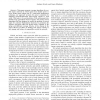Free Online Productivity Tools
i2Speak
i2Symbol
i2OCR
iTex2Img
iWeb2Print
iWeb2Shot
i2Type
iPdf2Split
iPdf2Merge
i2Bopomofo
i2Arabic
i2Style
i2Image
i2PDF
iLatex2Rtf
Sci2ools
ICRA
2008
IEEE
2008
IEEE
Deployment algorithms for a power-constrained mobile sensor network
Abstract— This paper presents coverage algorithms for mobile sensor networks in which agents have limited power to move. Rather than making use of a constrained optimization technique, our approach accounts for power constraints by assigning non-homogeneously time-varying regions to each robot. This leads to a novel partition of the environment into limited-range, generalized Voronoi regions. The motion control algorithms are then designed to ascend the gradient of several types of Locational Optimization functions. In particular, the objective functions reflect the global energy available to the group and different coverage criteria. As we discuss in the paper, this has an effect on limiting each agent’s velocity to save energy and balance its expenditure across the network.
Constrained Optimization Technique | ICRA 2008 | Locational Optimization Functions | Paper Presents Coverage | Robotics |
| Added | 30 May 2010 |
| Updated | 30 May 2010 |
| Type | Conference |
| Year | 2008 |
| Where | ICRA |
| Authors | Andrew Kwok, Sonia Martínez |
Comments (0)

